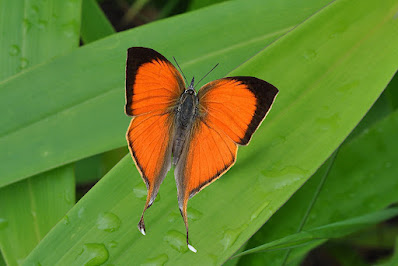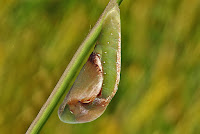<> Loxura atymnus (Cramer, 1782) <>
the Common Yamfly ผีเสื้อแสดหางยาว
Click on any photo to see all photos full size in Lightbox
Additions and corrections to the information provided on this page is always welcome. Please use the Contact form.

Photo taken at Doi Suthep-Pui National Park, Chiang Mai, Thailand. 460m a.s.l.

Loxura atymnus is widely distributed across the whole region and is fairly common in many places. It is a small medium size butterfly and the sexes are similar to each other both in size and appearance. There is a white-tipped tail on each hindwing. Both sexes occasionally bask on vegetation just a metre or two above ground level. Males are sometimes seen puddling but usually in sheltered locations rather than on riverbanks or other open areas. The species has been reported feeding on the extrafloral nectaries of some plants including Spathoglottis plicata, a ground orchid, but are not known to regularly visit flowers for nectar.
The species is multivoltine and with a relatively short life cycle there are multiple generations each year. This does vary however according to temperature and there are less generations in the northern part of the region than there are in the south. The adult female lays her eggs singly at the base of young shoots on the host plant. After hatching the larvae consume their egg shell as their first meal. The larvae are rather unusual and are almost slug-like in appearance.
Synonyms and previously used names: Hesperia atymnus, Papilio atymnus, Myrina atymnus, Marmessus atymnus
Taxonomy: Animalia - Arthropoda - Insecta - Lepidoptera - Lycaenidae - Theclinae - Loxura - atymnus
Regional subspecies: Loxura atymnus continentalis (Nepal, India, Myanmar, Thailand, Laos, Cambodia, Vietnam, S.China), L.atymnus deinostratus (Java-Indonesia), L.atymnus fuconius (S.Thailand, W.Malaysia, Singapore, Borneo-Indonesia), L.atymnus leminius (Sumatra-Indonesia), L.atymnus luzonica (Philippines). Others found on individual islands of Indonesia include - matienus, manilius, intermedius, kangeanus, sulawesiensis
Regional Distribution: Nepal, Bhutan, India, Bangladesh, Myanmar, Thailand, Laos, Cambodia, Vietnam, China, Malaysia, Singapore, Indonesia, Philippines
 |
| Lamnamkok National Park, Chiang Rai, Thailand 450m a.s.l. |
Habitat: Loxura atymnus is found in open areas of primary rainforest, secondary lowland forest, plantations, and moist montane forest. It sometimes visits urban parks and gardens. It is usually encountered at low to moderate elevations and has been recorded up to 2100m a.s.l.
Flight time: all year, depending on location Wingspan: 33-38mm
Life History: egg 2-3 days instar 1 2-3 days instar 2 3-4 days instar 3 3-4 days instar 4 3-4 days instar 5 n/a pupa 7-8 days Total egg to adult 21-26 days
All times are approximate and can vary depending on the season and on the host used.
Larval Hosts: Smilax bracteata, Smilax corbularia, Smilax perfoliata, Smilax zeylanica (Smilacaceae), Dioscorea alata, Dioscorea hispida, Dioscorea pentaphylla (Dioscoreaceae), Solanum tuberosum (Solanaceae).
Actual host plant used depends upon location and availabilty of plant species.
Adult Food Sources: Nectar - this species doesn't usually visit flowers but is believed to feed on the extrafloral nectaries found on some plants. These are specialised nectar-secreting plant glands that develop outside of flowers and are not involved in pollination. These glands are generally located on the leaf or petiole. Other - mud puddling, over-ripe fruit, animal dung.
 |
| Doi Suthep-Pui National Park, Chiang Mai, Thailand |
 |
| Doi Suthep-Pui National Park, Chiang Mai, Thailand |
 |
| Luang Prabang, Laos |
 |
| Spathoglottis plicata |
Links to other pages in this series for species in the same subfamily






